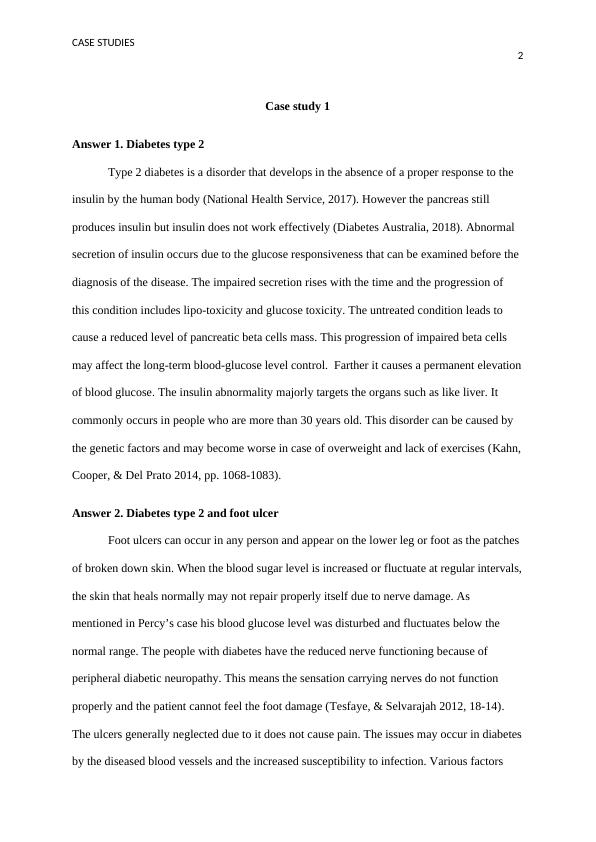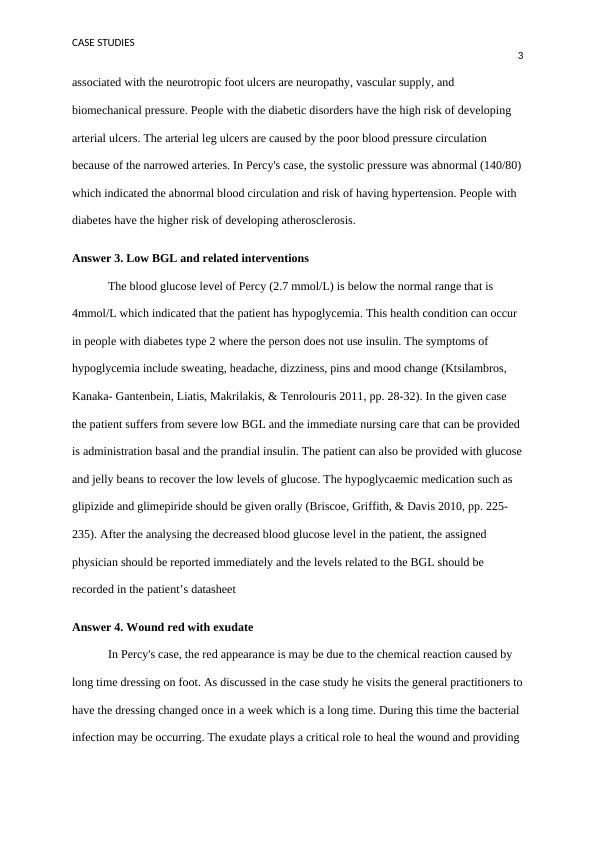Analyze and Respond to Client’s Health Information - Case Studies
Added on 2023-06-08
15 Pages4171 Words92 Views
Running Head: CASE STUDIES
0
Analyze and respond to client’s health information
Student details
[Pick the date]
0
Analyze and respond to client’s health information
Student details
[Pick the date]

CASE STUDIES
1
Table of Contents
Case study 1...............................................................................................................................3
Answer 1. Diabetes type 2......................................................................................................3
Answer 2. diabetes type 2 and foot ulcer...............................................................................3
Answer 3. Low BGL and related interventions......................................................................3
Answer 4. Wound red with exudate.......................................................................................3
Answer 5. Three health professionals....................................................................................4
Case study 2...............................................................................................................................4
Answer 6. Urinalysis..............................................................................................................5
Answer 7. Risk factors of UTI...............................................................................................5
Answer 8. The relation between temperature and infection...................................................5
Answer 9. TIA and CVA........................................................................................................5
Answer 10. Three health professionals..................................................................................6
Case Study 3...............................................................................................................................7
Answer 11. Genetics of cystic fibrosis..................................................................................7
Answer 12. Impacts of CF on respiratory system..................................................................7
Answer 13. Impact of CF on male fertility.............................................................................7
Answer 14. Impacts of pregnancy on respiratory system.......................................................7
Answer 15. Three health professionals..................................................................................7
References..................................................................................................................................9
1
Table of Contents
Case study 1...............................................................................................................................3
Answer 1. Diabetes type 2......................................................................................................3
Answer 2. diabetes type 2 and foot ulcer...............................................................................3
Answer 3. Low BGL and related interventions......................................................................3
Answer 4. Wound red with exudate.......................................................................................3
Answer 5. Three health professionals....................................................................................4
Case study 2...............................................................................................................................4
Answer 6. Urinalysis..............................................................................................................5
Answer 7. Risk factors of UTI...............................................................................................5
Answer 8. The relation between temperature and infection...................................................5
Answer 9. TIA and CVA........................................................................................................5
Answer 10. Three health professionals..................................................................................6
Case Study 3...............................................................................................................................7
Answer 11. Genetics of cystic fibrosis..................................................................................7
Answer 12. Impacts of CF on respiratory system..................................................................7
Answer 13. Impact of CF on male fertility.............................................................................7
Answer 14. Impacts of pregnancy on respiratory system.......................................................7
Answer 15. Three health professionals..................................................................................7
References..................................................................................................................................9

CASE STUDIES
2
Case study 1
Answer 1. Diabetes type 2
Type 2 diabetes is a disorder that develops in the absence of a proper response to the
insulin by the human body (National Health Service, 2017). However the pancreas still
produces insulin but insulin does not work effectively (Diabetes Australia, 2018). Abnormal
secretion of insulin occurs due to the glucose responsiveness that can be examined before the
diagnosis of the disease. The impaired secretion rises with the time and the progression of
this condition includes lipo-toxicity and glucose toxicity. The untreated condition leads to
cause a reduced level of pancreatic beta cells mass. This progression of impaired beta cells
may affect the long-term blood-glucose level control. Farther it causes a permanent elevation
of blood glucose. The insulin abnormality majorly targets the organs such as like liver. It
commonly occurs in people who are more than 30 years old. This disorder can be caused by
the genetic factors and may become worse in case of overweight and lack of exercises (Kahn,
Cooper, & Del Prato 2014, pp. 1068-1083).
Answer 2. Diabetes type 2 and foot ulcer
Foot ulcers can occur in any person and appear on the lower leg or foot as the patches
of broken down skin. When the blood sugar level is increased or fluctuate at regular intervals,
the skin that heals normally may not repair properly itself due to nerve damage. As
mentioned in Percy’s case his blood glucose level was disturbed and fluctuates below the
normal range. The people with diabetes have the reduced nerve functioning because of
peripheral diabetic neuropathy. This means the sensation carrying nerves do not function
properly and the patient cannot feel the foot damage (Tesfaye, & Selvarajah 2012, 18-14).
The ulcers generally neglected due to it does not cause pain. The issues may occur in diabetes
by the diseased blood vessels and the increased susceptibility to infection. Various factors
2
Case study 1
Answer 1. Diabetes type 2
Type 2 diabetes is a disorder that develops in the absence of a proper response to the
insulin by the human body (National Health Service, 2017). However the pancreas still
produces insulin but insulin does not work effectively (Diabetes Australia, 2018). Abnormal
secretion of insulin occurs due to the glucose responsiveness that can be examined before the
diagnosis of the disease. The impaired secretion rises with the time and the progression of
this condition includes lipo-toxicity and glucose toxicity. The untreated condition leads to
cause a reduced level of pancreatic beta cells mass. This progression of impaired beta cells
may affect the long-term blood-glucose level control. Farther it causes a permanent elevation
of blood glucose. The insulin abnormality majorly targets the organs such as like liver. It
commonly occurs in people who are more than 30 years old. This disorder can be caused by
the genetic factors and may become worse in case of overweight and lack of exercises (Kahn,
Cooper, & Del Prato 2014, pp. 1068-1083).
Answer 2. Diabetes type 2 and foot ulcer
Foot ulcers can occur in any person and appear on the lower leg or foot as the patches
of broken down skin. When the blood sugar level is increased or fluctuate at regular intervals,
the skin that heals normally may not repair properly itself due to nerve damage. As
mentioned in Percy’s case his blood glucose level was disturbed and fluctuates below the
normal range. The people with diabetes have the reduced nerve functioning because of
peripheral diabetic neuropathy. This means the sensation carrying nerves do not function
properly and the patient cannot feel the foot damage (Tesfaye, & Selvarajah 2012, 18-14).
The ulcers generally neglected due to it does not cause pain. The issues may occur in diabetes
by the diseased blood vessels and the increased susceptibility to infection. Various factors

CASE STUDIES
3
associated with the neurotropic foot ulcers are neuropathy, vascular supply, and
biomechanical pressure. People with the diabetic disorders have the high risk of developing
arterial ulcers. The arterial leg ulcers are caused by the poor blood pressure circulation
because of the narrowed arteries. In Percy's case, the systolic pressure was abnormal (140/80)
which indicated the abnormal blood circulation and risk of having hypertension. People with
diabetes have the higher risk of developing atherosclerosis.
Answer 3. Low BGL and related interventions
The blood glucose level of Percy (2.7 mmol/L) is below the normal range that is
4mmol/L which indicated that the patient has hypoglycemia. This health condition can occur
in people with diabetes type 2 where the person does not use insulin. The symptoms of
hypoglycemia include sweating, headache, dizziness, pins and mood change (Ktsilambros,
Kanaka- Gantenbein, Liatis, Makrilakis, & Tenrolouris 2011, pp. 28-32). In the given case
the patient suffers from severe low BGL and the immediate nursing care that can be provided
is administration basal and the prandial insulin. The patient can also be provided with glucose
and jelly beans to recover the low levels of glucose. The hypoglycaemic medication such as
glipizide and glimepiride should be given orally (Briscoe, Griffith, & Davis 2010, pp. 225-
235). After the analysing the decreased blood glucose level in the patient, the assigned
physician should be reported immediately and the levels related to the BGL should be
recorded in the patient’s datasheet
Answer 4. Wound red with exudate
In Percy's case, the red appearance is may be due to the chemical reaction caused by
long time dressing on foot. As discussed in the case study he visits the general practitioners to
have the dressing changed once in a week which is a long time. During this time the bacterial
infection may be occurring. The exudate plays a critical role to heal the wound and providing
3
associated with the neurotropic foot ulcers are neuropathy, vascular supply, and
biomechanical pressure. People with the diabetic disorders have the high risk of developing
arterial ulcers. The arterial leg ulcers are caused by the poor blood pressure circulation
because of the narrowed arteries. In Percy's case, the systolic pressure was abnormal (140/80)
which indicated the abnormal blood circulation and risk of having hypertension. People with
diabetes have the higher risk of developing atherosclerosis.
Answer 3. Low BGL and related interventions
The blood glucose level of Percy (2.7 mmol/L) is below the normal range that is
4mmol/L which indicated that the patient has hypoglycemia. This health condition can occur
in people with diabetes type 2 where the person does not use insulin. The symptoms of
hypoglycemia include sweating, headache, dizziness, pins and mood change (Ktsilambros,
Kanaka- Gantenbein, Liatis, Makrilakis, & Tenrolouris 2011, pp. 28-32). In the given case
the patient suffers from severe low BGL and the immediate nursing care that can be provided
is administration basal and the prandial insulin. The patient can also be provided with glucose
and jelly beans to recover the low levels of glucose. The hypoglycaemic medication such as
glipizide and glimepiride should be given orally (Briscoe, Griffith, & Davis 2010, pp. 225-
235). After the analysing the decreased blood glucose level in the patient, the assigned
physician should be reported immediately and the levels related to the BGL should be
recorded in the patient’s datasheet
Answer 4. Wound red with exudate
In Percy's case, the red appearance is may be due to the chemical reaction caused by
long time dressing on foot. As discussed in the case study he visits the general practitioners to
have the dressing changed once in a week which is a long time. During this time the bacterial
infection may be occurring. The exudate plays a critical role to heal the wound and providing

End of preview
Want to access all the pages? Upload your documents or become a member.
Related Documents
Foot Ulcer and Diabetes: Pathophysiology, Impact, and Management Strategieslg...
|10
|2503
|487
Managing Diabetic Foot Ulcers: Pathophysiology, Risk Factors, and Treatmentlg...
|14
|2718
|410
Diabetes Case Study: Analysis, Pathophysiology, and Nursing Managementlg...
|10
|2527
|2
Health Information and Response to Clientlg...
|8
|2608
|363
Pathophysiology, Nursing Priorities and Management of Diabetic Foot Ulcer: A Case Studylg...
|10
|2726
|139
Nursing Asignment Case Study 2022lg...
|8
|2424
|30
